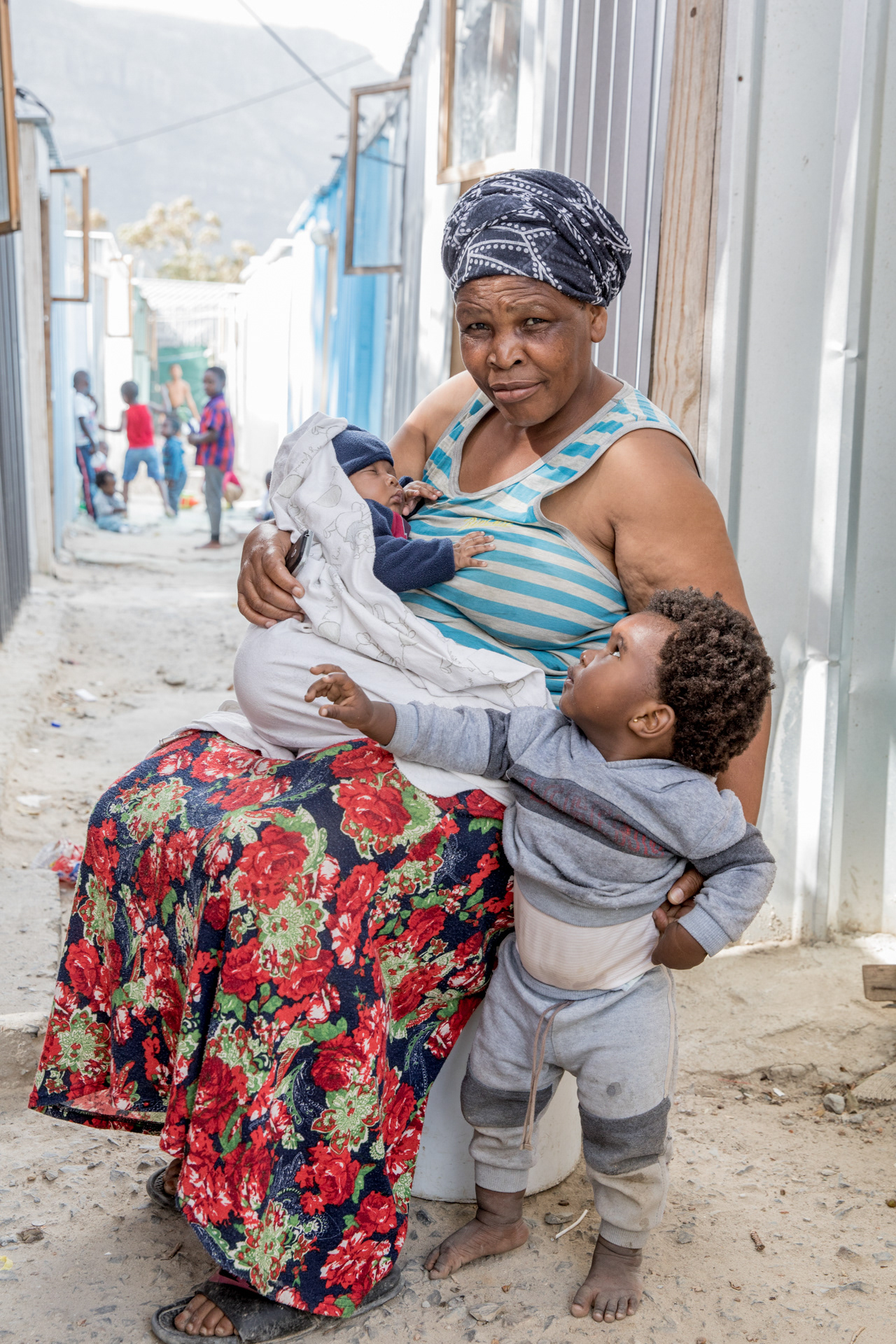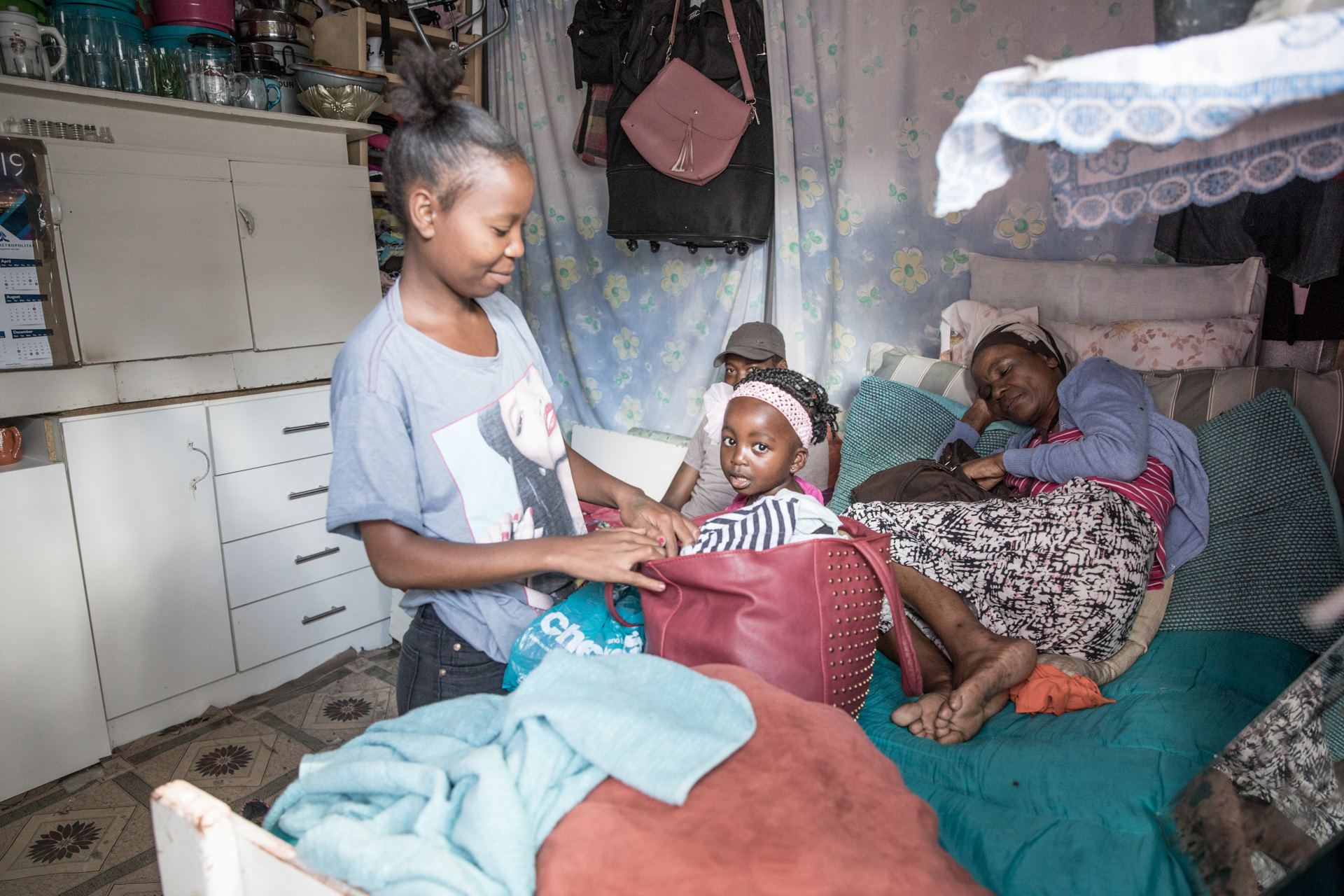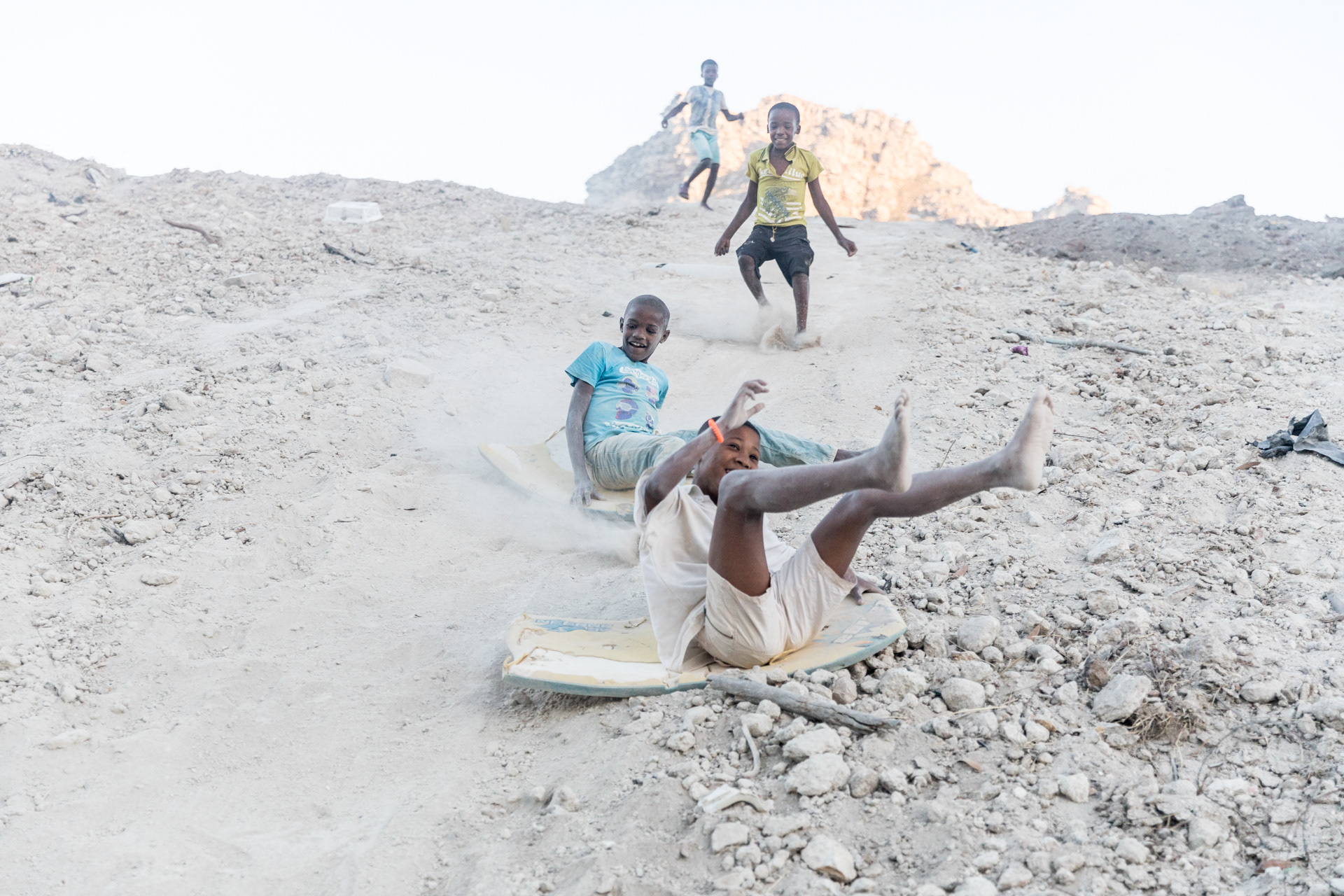
Livakele Dingwayo repairs his go-kart with the help of friend Amvuyele Maphempeni outside his home on the slopes of IY.

Nonstapo Maqabuka with infant granddaughter Alunamda and grandson Inako outside the 3x6 meter home she shares with her grandchildren and daughter.
Sunday Times, 3 March, 2019
Walking through Imizamo Yethu (or IY as it is called around here) I can, for a moment, imagine I am in a quaint Italian village. The alleyways are narrow, the ground is cobbled underfoot, and the view is wonderful. The moment passes as the stench grabs hold of my gut. I’m walking along an alley carved by sewerage, slipping on rocks that channel effluent downhill, bordered by shack walls made of sheet metal and pilfered road signs.
The view, however, remains wonderful because IY looks onto prime real estate. Sol Kerzner’s impressive home is on the opposite slope, and a leafy valley below resounds to the clip-clop of horse-back riders. Up here in IY, the steel walls on my left bounce to the beat of Reggae music and the walls opposite vibrate with the passion of Gospel.
As a bishop of the Salem Apostolic church in Zion, IY resident Owen Xubuzane finds salvation in preaching, which sometimes involves nightlong vigils followed by baptisms at sunrise. He is also an intern teacher at the local Silikamva High School, and he is IY’s citizen journalist.
Trained by the non-profit Cape Digital Foundation, Xubuzane is the presenter, cameramen and editor of IY TV. With a cellphone and a basic editing app, he makes daily online broadcasts of the goings on in IY, everything from budding musical talent to the plight of fire victims in the Temporary Relocation Area (TRA), which is where we are heading. We have just interviewed tattoo artist, Joseph, in his shack at the top of IY. He spoke to us through a haze of sweet smelling smoke while stabbing a new design into the skin on his ankle using orange ink and a sewing needle.
From the highest vantage point at the top of IY the view is spectacular, particularly whilst defecating, perched on a rock, like people do when the council toilets are bunged up or broken, which is often. Down at the bottom of IY the sewerage eventually exits the alley and fans out onto a flight of steps leading to a traffic circle. Here, cars towing horse-boxes meet “amaphela” (informal taxis nicknamed “cockroaches”) in a churning gyre of wealth and poverty.
We pass a small cafe on the right where local tour guide Kenny Tokwe has lunch and meets tourists with a philanthropic bent, then we pass row upon row of portable toilets and enter the TRA. Compared to the labyrinth of steel shacks on the higher slopes, it is regimented, uniform, like a refugee camp.

Owen Xubuzane, far left, became intrigued by digital media when he worked as a technician installing internet networks for TooMuchWifi in Imizamo Yethu. He signed up for a workshop at the University of the Western Cape, where he met Cape Digital Foundation CEO Emma Kaye, who appointed him “citizen journalist” for IY TV, an Imizamo Yethu community broadcaster. Here Xubuzane records a segment about faith with a local Rasta.

Sigidi Yakhanani stands proudly between her school certificates in her family’s home on the upper slopes of IY.

Emihle Nkomana stands outside his family’s 3x3 meter home with infant brother Uminathi and neighbours Ziyanda and Simphiwe Mcaphukisi.

Khowulezile Mcaphukisi breast feeds her baby outside the 3x3 shack she shares with her husband and six children.

Molawa Dumezweni who is lying on a bed nursing a bout of flu while her family sits alongside.
3 generations in a 3x3 shack
After the 2017 fire, concerned citizens engaged with City Council to ensure such a tragedy never happened again. They recognised the need for better infrastructure, better housing, and better access by road so emergency vehicles could reach the area. Lack of access was the key reason for the 2017 disaster.
At the core of the new plan was an initiative called super-blocking. The area affected by fire would be re-zoned and afforded better infrastructure such as roads, sanitation and underground electricity. During that time affected residents would move into a TRA built on municipal land.
Housing in the TRA comprises shacks of 3x3 meters; families of four or more were allocated two shacks that could be joined together. Some families weren’t so lucky. Outside one 3x3 I meet Khowulezile Mcaphukisi who is breast feeding her baby. She invites me in to meet her husband and older daughter, and she puts her baby on the bed with two toddlers who are sleeping. Another two children are on their way back from school making a total of 8 who share a space the size of a bedroom.
A few shacks along I meet Molawa Dumezweni who is lying on a bed nursing a bout of flu while her family sits alongside. Dumezweni coughs a phlegmy greeting as I step inside. Chances are her son-in-law, daughter, and granddaughter will catch the same flu. The story is repeated a bit further along: 3 generations in a 3x3.
One of the supporters of super-blocking was community leader Ziyanda Phandle. She no longer lives in IY because she and her family were threatened by residents who refused to relocate to the TRA. Phandle explains that while discussions were underway with the city after the 2017 disaster, many who opposed the super-blocking rebuilt on the land laid waste by fire thereby putting formal development on hold. What made matters worse is that non-residents took advantage of the situation and built there too, on land that was never theirs to begin with.
“We are in a court proceedings with 200 households who rebuilt after the fire,” says ward councillor Roberto Quintas, indicating that those households need to make way for a new road. “In order to get the super-blocking project underway we need to get that road sorted out.”
Land above a nearby cemetery has been developed as a temporary relocation area for these households, but the residents have rejected the city’s terms.
“They are sitting on a ticking bomb because the fire can happen any time. The reason that fire affected so many families is because there is no room for fire fighters to go in,” Phandle says. “The shacks are closer to each other so there is no way for people to move to get their stuff out of the way.”
Even if the deadlock was resolved immediately, the likelihood of redevelopment being completed is 18 to 24 months away. But there is no resolution. The result is thousands of people are stuck in the TRA, and thousands are perched precariously on the slopes in shacks that are in a worse state than those they replaced.
3 generations in one 3x3. Nceba Mxhosa cuts his niece Anthi’s hair while her grandfather Phakamile Njaba looks on.
Many ordeals by fire
Fires are relatively frequent here. In February 2018 a fire gutted 100 homes leaving 350 homeless. Three weeks ago, a fire razed 19 homes displacing over 90 people. Fortunately it was mid-morning when the fire occurred. It was brought under control by citizens and firefighters who had to climb up hill dragging hoses through convoluted allies to reach the flames. Visiting the sight the next morning, I noticed construction of new shacks was already underway while scrap collectors scrounged what they could, to sell or to rebuild.
Xubuzane says the fire started when the electricity returned after a power outage. “They left a pot of food on a hot plate which they forgot to turn off before going to work,” he says. The power returned and the place was soon in flames.
Leaving the site of the fire, I follow a series of alleyways and notice wires streaming from transformer boxes above, crossing haphazardly and sometimes gathering in knots. Some of them wind around trees, and some act as washing lines.
Flames of hope do spring up every now and then. A separate formal housing development has gone on unimpeded by the 2017 fire. This could relieve some pressure but structures will only be in place by the end of 2020 at the earliest.
Some Hout Bay residents on the border of IY recognise the need for more land. A number of land owners in neighbouring Hughenden have offered to sell their land to the city at what they deem fair market prices. “I realised we could be part of the solution by offering this land so they could build low cost housing,” says IY neighbour, Deon Robbertz. But there are the slow mechanisms of bureaucracy, and the concern that land made available could be taken over by squatters. Another issue is that Meadows, the suburb next along, looks at Hughenden as a buffer zone and does not want them to sell.
Other Hout Bay residents spring to action when disaster occurs in IY. Volunteers from non-profit Thula Thula Hout Bay provided basic relief for victims of the 2017 fire, as well as the more recent ones, in the form of food, blankets and other necessities. Another organisation regularly involved with the TRA is Community Cook Up IY. At the core of their program is a feeding scheme that provides healthy meals to children every Friday evening.
Cook Up IY provides healthy meals to kids every friday evening.

Boxing trainer Zamikhaya ZAMAX Maxapana drills Lamkhelo Manikonkwana while trainees Lutho Gamnca and Kwenzekile Mrobo look on.

Fellow trainees form a makeshift ring by holding hands and encircling the opponents.
Citizen journalist Owen Xubuzane interviews tattoo artist Phelo Mantangana for IY TV.
Hout Bay residents spring to action
Organisers Camilla Wilson and Tjarla Norton live in Hout Bay and appeal for donations of food, cooking and eating utensils from Hout Bay residents and businesses.
I join Cook Up IY one Friday evening as they set up pots of steaming hot food, and brace themselves as the kids came rushing. Wilson and volunteers take plates of food to a makeshift gym where trainer Luzukho takes local boys through the rigours of boxing. The trainees stand in a circle, holding hands to form a boxing ring. Two boys slip on their gloves and go at it with the passion only poverty can inspire. Steam from the food mingles with the steam of perspiration - a flurry of punches, and a bruised ego, quenched by the promise of a good meal.
Outside, other kids queue frantically for food. Volunteers bark orders to keep them in line. Some kids start eating the moment the food hits their plate, others move off to sit and eat at the foot of council toilets.
In the TRA there is one toilet for every five households, on average that is one toilet per 25 people. The toilet components are the cheap plastic variety that breaks easily. The sewerage system struggles with the load resulting in overflowing cisterns. Wilson tells me that the portable toilets left behind after the council toilets were built serve double duty. The problem is they are not serviced any longer.
It becomes clear when I visit a local shebeen why Friday is Cook Up IYs evening of choice. Many TRA parents are too drunk on the weekend to contemplate feeding children. One intoxicated woman collapses at the doorway of the shebeen. A lone infant watches from the alley nearby.
“Those people are not staying there because they want to stay there. They are staying there because they want what the City of Cape Town promised them,” says Phandle.
Apart from budding musicians and tattoo artists, Xubuzane is broadcasting the story of the people in the 3x3s. While I am there, he interviews residents who are collecting water. They turn on the tap at the end of a row of toilets and brown water gushes out. We wait 10 minutes before it clears to a light beige colour that is deemed usable.

Cisco Ramosie and Emihle Morris slide down a construction site for formal housing chased by friends Mark Boois and Kyle Anthony.

Ciscoe Ramosie after a fall.
Digital hitech among the shacks
Despite the terrible infrastructure Imizamo Yethu is more technically advanced than many urban areas in one way. The company TooMuchWifi delivers affordable internet to IY via routers in local businesses such as spazas, and hairdressers. As such, residents benefit from one internet provider throughout much of IY without having to switch between different operators, or paying the exorbitant prices of cellular companies.
They are also free to watch IY TV. The Cape Digital Foundation believes in the enabling citizens to solve real world problems through technology, and IY TV is finding its place as a multifaceted local resource. Not only can locals catch up on the latest news, but they can list their business on IY TVs website for free, and learners from grade 4 through 9 can do school exercises using a large range of digital workbooks.
Aiming for Silikamva High School at the top of IY, I leave the TRA and walk up an alley. The sun hits the rocky pinnacle above the shanty town, painting it a rustic gold. Then Gospel music brings me back to earth and I trudge between the shacks. I lose my way, turn back, and find another alley that doubles as a sewerage trench. It’s a sign that this is the way to the top. Passing an open door, a woman smiles at me as she packs a large suitcase. Perhaps she’s found a way out of this purgatorial maze. But I don’t ask directions, I trudge on as if I know the way. But I don’t. I don’t think anyone really does.